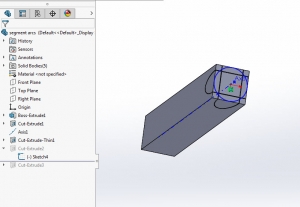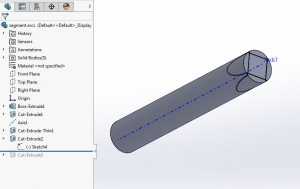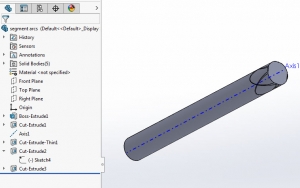Marmotjr
Member
Is there any software out there to help design segmented pens? There's things like CutList and an app for design segmented cutting boards, so I'd think there might be a segmented pen one too.
Right.
No.
I'm not talking about using premade designs.
I'm talking about designing, from scratch, YOUR OWN segmented pen design, and then having a piece of software HELP layout the wood for cutting and gluing.
The software is just a tool.
Of course, we could take that point of view and go with no CAD software, or Drawings at all even! Why, cell phones, all phones in general even, remove the need for proper communication! Why even bother using the car, when you can walk over to the other person and talk directly! Thanks for the ludittical answer though.
Luddite | Definition of Luddite by Merriam-Webster
Luddite | Definition of Luddite by Merriam-Webster
With the onset of the information age, Luddite gained a broader sense describing anyone who shuns new technology. Origin and Etymology of luddite.
The computer is only as good as the operator allows it to be. We still need imagination.
Hey Thad! Don't invent "Skew Technique"... study and try to learn from the Masters... :wink:
Use what tools, prior accessible knowledge and shared lessons are available to your own progression in your craft. (AKA: design assistants).
Yo Yo Ma will have no career as a solo cellist after he no longer can "Imitate" the Standard Classic Repertoire.
Paganini could not compose well, but his technique for violin is a standard series of life-long lessons to aspire to (good luck).
Verracchio is not a house-hold name, but he did teach, instruct and inspire many students... including Leonardo da Vinci (who - horrors - was made to "imitate" the work of the masters.) Leo did quite well.
And Modest Mussorgsky was a wonderful composer and pianist, but his "kernels of masterpieces" did not reach acclaim until they were studied, imitated and improved by others (i.e.: Night on Bald Mountain - Rimsky Korsakov; Pictures at an Exhibition - Maurice Ravel).
Using the available tools and learning your craft (aka: segmenting), should include (IN MY OPINION ONLY!) studying what others have done, refining your skills, and then producing the best you can produce.
(...and, When you hear Ravel's "Pictures at an Exhibition" by the Cleveland Orchestra, it is always credited as an arrangement of M. Mussorgsky - with no apology!). Those who inspire use deserve credit!
Apologies for the long explanation to a much shorter response, but I graduated with a degree in Music Education and was expected to teach students the next 40 years to "Study, imitate, and be inspired by Master's of the art). In fact, I was to be judged and evaluated by my ability to teach students to imitate!
Now for the much shorter response:
I use an excel spreadsheet to diagram a side view and and end view of my segments. Cumbersome, not a fancy CAD program, and it simply shows me what I can also diagram with a pencil and paper, but much more accurately and cleanly (my penmanship/pencilmanship is rather poor).
Finally, I have no problem with sharing concepts on segmenting - this is only the beginning! Precision, accuracy, repeatability, and an eye for what materials are comparable are the real challenge (you can buy a lathe and chisels and be told how to use them, then it is up to you to take the next 2,5 10 years to perfect your skills!)
Hey Thad! Don't invent "Skew Technique"... study and try to learn from the Masters... :wink:
Use what tools, prior accessible knowledge and shared lessons are available to your own progression in your craft. (AKA: design assistants).
Yo Yo Ma will have no career as a solo cellist after he no longer can "Imitate" the Standard Classic Repertoire.
Paganini could not compose well, but his technique for violin is a standard series of life-long lessons to aspire to (good luck).
Verracchio is not a house-hold name, but he did teach, instruct and inspire many students... including Leonardo da Vinci (who - horrors - was made to "imitate" the work of the masters.) Leo did quite well.
And Modest Mussorgsky was a wonderful composer and pianist, but his "kernels of masterpieces" did not reach acclaim until they were studied, imitated and improved by others (i.e.: Night on Bald Mountain - Rimsky Korsakov; Pictures at an Exhibition - Maurice Ravel).
Using the available tools and learning your craft (aka: segmenting), should include (IN MY OPINION ONLY!) studying what others have done, refining your skills, and then producing the best you can produce.
(...and, When you hear Ravel's "Pictures at an Exhibition" by the Cleveland Orchestra, it is always credited as an arrangement of M. Mussorgsky - with no apology!). Those who inspire use deserve credit!
Apologies for the long explanation to a much shorter response, but I graduated with a degree in Music Education and was expected to teach students the next 40 years to "Study, imitate, and be inspired by Master's of the art). In fact, I was to be judged and evaluated by my ability to teach students to imitate!
Now for the much shorter response:
I use an excel spreadsheet to diagram a side view and and end view of my segments. Cumbersome, not a fancy CAD program, and it simply shows me what I can also diagram with a pencil and paper, but much more accurately and cleanly (my penmanship/pencilmanship is rather poor).
Finally, I have no problem with sharing concepts on segmenting - this is only the beginning! Precision, accuracy, repeatability, and an eye for what materials are comparable are the real challenge (you can buy a lathe and chisels and be told how to use them, then it is up to you to take the next 2,5 10 years to perfect your skills!)
Shouldn't you be enjoying your vacation!! Maybe do some diving and check out the beautiful scenery :wink:
Unless there is some new wave of segmenting to about to hit the scene, everything seen here has been done and done many times over. There are formulas for compound angles and here is a good free site for that
Compound Miter Saw Calculator
But visualizing segmenting is in the eye of the beholder. The one thing I have said over and over the canvas you are working with is so small so incorporating some fancy design is not possible. Unlike a bowl or plate where feature rings are the norm.
Combining elements is what makes some segmented pens stand out along with using varied materials.
I am truely interested in new ideas and I hope there are some that come along and shared.
Unless there is some new wave of segmenting to about to hit the scene, everything seen here has been done and done many times over. There are formulas for compound angles and here is a good free site for that
Compound Miter Saw Calculator
But visualizing segmenting is in the eye of the beholder. The one thing I have said over and over the canvas you are working with is so small so incorporating some fancy design is not possible. Unlike a bowl or plate where feature rings are the norm.
Combining elements is what makes some segmented pens stand out along with using varied materials.
I am truely interested in new ideas and I hope there are some that come along and shared.
Isn't that considered pessimistic thinking? I was told that ANYTHING is possible. A person just has to have the dedication to realize the end goal. If people always believed it, when they were told it isn't possible, we would never progress. Edison was told that a light bulb wasn't possible...
One person's impossible, is another's ability.
I have seen some very intricate designs made by the Gisi brothers. There have been others, but the Gisi's stand out to me right now. So, I believe if someone wanted to, they could take it ever farther and more intricate.
Unless there is some new wave of segmenting to about to hit the scene, everything seen here has been done and done many times over. There are formulas for compound angles and here is a good free site for that
Compound Miter Saw Calculator
But visualizing segmenting is in the eye of the beholder. The one thing I have said over and over the canvas you are working with is so small so incorporating some fancy design is not possible. Unlike a bowl or plate where feature rings are the norm.
Combining elements is what makes some segmented pens stand out along with using varied materials.
I am truely interested in new ideas and I hope there are some that come along and shared.
Isn't that considered pessimistic thinking? I was told that ANYTHING is possible. A person just has to have the dedication to realize the end goal. If people always believed it, when they were told it isn't possible, we would never progress. Edison was told that a light bulb wasn't possible...
One person's impossible, is another's ability.
I have seen some very intricate designs made by the Gisi brothers. There have been others, but the Gisi's stand out to me right now. So, I believe if someone wanted to, they could take it ever farther and more intricate.
Go for it. If you look back I have been a member here since 2005 and I always promoted segmenting and in fact it was I who encouraged the segmenting forum so no need to preach to me segmenting. I encourage all to develop some more segmenting pens and develop those different techniques. Anything is possible so prove me wrong please please please. I do not know how else to say it. If my statement provokes you or anyone else to prove me wrong then my mission is accomplished.
How do you think the Celtic Knot was created, the 360 herringbone, and I can go on and on. Think outside the box and use your imagination.
Prove me wrong, lets go.
Unless there is some new wave of segmenting to about to hit the scene, everything seen here has been done and done many times over. There are formulas for compound angles and here is a good free site for that
Compound Miter Saw Calculator
But visualizing segmenting is in the eye of the beholder. The one thing I have said over and over the canvas you are working with is so small so incorporating some fancy design is not possible. Unlike a bowl or plate where feature rings are the norm.
Combining elements is what makes some segmented pens stand out along with using varied materials.
I am truely interested in new ideas and I hope there are some that come along and shared.
Well, just whipped up a blank in Sketchup, and then tried to drop a cylinder through it and intersect the faces. Problem is, Objects in SU are only textured on their surface, not the interior, so I was just left with blank surfaces on the cylinder. If anybody knows how to extend textures, let me know!



